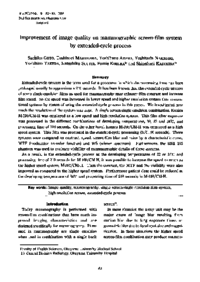

Bulletin of Faculty of Health Sciences Okayama University Medical School
Published by Faculty of Health Sciences Okayama University Medical School <Formerly known as>
岡山大学医療技術短期大学部紀要 (1巻-9巻)
Extended-cycle processによる乳房撮影用増感紙/フィルムシステムの画質改善
Nakagiri, Yoshitada
Sugita, Katsuhiko
Kimura, Fumie
Kadohisa, Shigefumi
Published Date
1999-02-26
Abstract
Extended-cycle process is the term used for a processor in which the processing time has been prolonged usually to approximate 210 seconds. It has been known that the extended-cycle process of some single-emulsion films as used for mammography may enhance film contrast and increase
film speed. So the speed was increased in lower speed and higher resolution system than conventional systems by means of using the extended-cycle process in this paper. We investigated how much the resolution of the system was kept. A single screen-single emulsion combination, Konica
M-100/CM-H was employed as a low speed and high resolution system. This film after exposure was processed in the different combinations of developing temperatures, 30, 32 and 34℃, and processing time of 210 seconds. On the other hand, Konica M-200/CM-H was employed as a high speed system. This film was processed in the standard-cycle processing (34℃, 90 seconds). Those systems were compared on contrast, speed, screen-film blur and noise by a characteristic curve, MTF (modulation transfer function) and WS (wiener spectrum). Furthermore, the RMI 165 phantom was used to evaluate visibility of mammographic details of these systems. As a result, in the extended-cycle process at the developing temperatures of 32 or 34°C and
processing time of 210 seconds for M-100/CM-H, it was possible to increase the speed as much as the higher speed system, M-200/CM-H. Then the contrast, the MTF and the visibility were also improved as compared to the higher speed system. Furthermore patient dose could be reduced at
the developing temperature of 34℃ and processing time of 210 seconds in M-100/CM-H.
Keywords
image quality
mammography
single screen-single emulsion film system
high-resolution screen
extended-cycle process
ISSN
0917-4494
NCID
AN10355371
NAID
JaLCDOI
